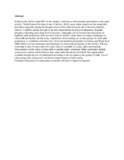Challenges and opportunities for clean milk production in the arid and semi-arid areas (ASALs) of Kenya

View/
Date
2012-04Author
Gitao, C G
Ngeiywa, K
Wanjohi, M
Language
enMetadata
Show full item recordAbstract
In Kenya the ASALs form 80% of the country’s land mass with nomadic pastoralism as the main
activity. North Eastern Province is one of the key ASAL areas where camels are the main milk providers
especially during the drought season when other livestock die or become unthrifty. About 1.7 million
camels are kept in an area characterized by dusty environment, frequent drought or flooding and a high
level of poverty. Although a lot of research has been done on highland milk production, little has been
done in ASALs where there are unique challenges to clean milk production. In this study, experiences
from training six women groups in clean milk production, is combined with interviews from one
hundred pastoralists in Garissa and Wajir from 2008-2010 to reveal constraints and challenges in
clean milk production in the ASALs. The key constraint is lack of water and even when water is
available it is salty, dirty and brackish. Unawareness on the value of clean milk is another major
constraint. Other constraints include conservative culture which believes that camel milk should not
be boiled. The opportunities available include the use of traditional knowledge to slowly improve
the quality of milk. Use of clean energy like solar power can lead to improvement of milk quality.
Continued education of communities on health will lead to improved hygiene.
Citation
Gitao C.G., Ngeiywa K., Wanjohi M.,April,2014.Challenges and opportunities for clean milk production in the arid and semi-arid areas (ASALs) of Kenya.Publisher
University of Nairobi
